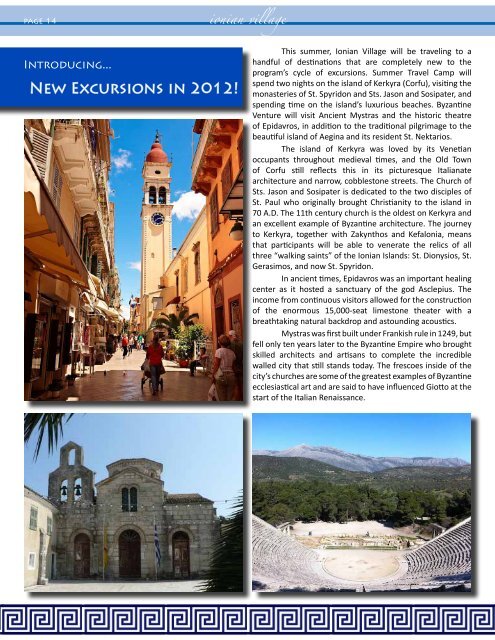Summer 2012 - Ionian Village
Summer 2012 - Ionian Village
Summer 2012 - Ionian Village
Create successful ePaper yourself
Turn your PDF publications into a flip-book with our unique Google optimized e-Paper software.
page 14 ionian village<br />
Introducing...<br />
New Excursions in <strong>2012</strong>!<br />
This summer, <strong>Ionian</strong> <strong>Village</strong> will be traveling to a<br />
handful of destinations that are completely new to the<br />
program’s cycle of excursions. <strong>Summer</strong> Travel Camp will<br />
spend two nights on the island of Kerkyra (Corfu), visiting the<br />
monasteries of St. Spyridon and Sts. Jason and Sosipater, and<br />
spending time on the island’s luxurious beaches. Byzantine<br />
Venture will visit Ancient Mystras and the historic theatre<br />
of Epidavros, in addition to the traditional pilgrimage to the<br />
beautiful island of Aegina and its resident St. Nektarios.<br />
The island of Kerkyra was loved by its Venetian<br />
occupants throughout medieval times, and the Old Town<br />
of Corfu still reflects this in its picturesque Italianate<br />
architecture and narrow, cobblestone streets. The Church of<br />
Sts. Jason and Sosipater is dedicated to the two disciples of<br />
St. Paul who originally brought Christianity to the island in<br />
70 A.D. The 11th century church is the oldest on Kerkyra and<br />
an excellent example of Byzantine architecture. The journey<br />
to Kerkyra, together with Zakynthos and Kefalonia, means<br />
that participants will be able to venerate the relics of all<br />
three “walking saints” of the <strong>Ionian</strong> Islands: St. Dionysios, St.<br />
Gerasimos, and now St. Spyridon.<br />
In ancient times, Epidavros was an important healing<br />
center as it hosted a sanctuary of the god Asclepius. The<br />
income from continuous visitors allowed for the construction<br />
of the enormous 15,000-seat limestone theater with a<br />
breathtaking natural backdrop and astounding acoustics.<br />
Mystras was first built under Frankish rule in 1249, but<br />
fell only ten years later to the Byzantine Empire who brought<br />
skilled architects and artisans to complete the incredible<br />
walled city that still stands today. The frescoes inside of the<br />
city’s churches are some of the greatest examples of Byzantine<br />
ecclesiastical art and are said to have influenced Giotto at the<br />
start of the Italian Renaissance.


